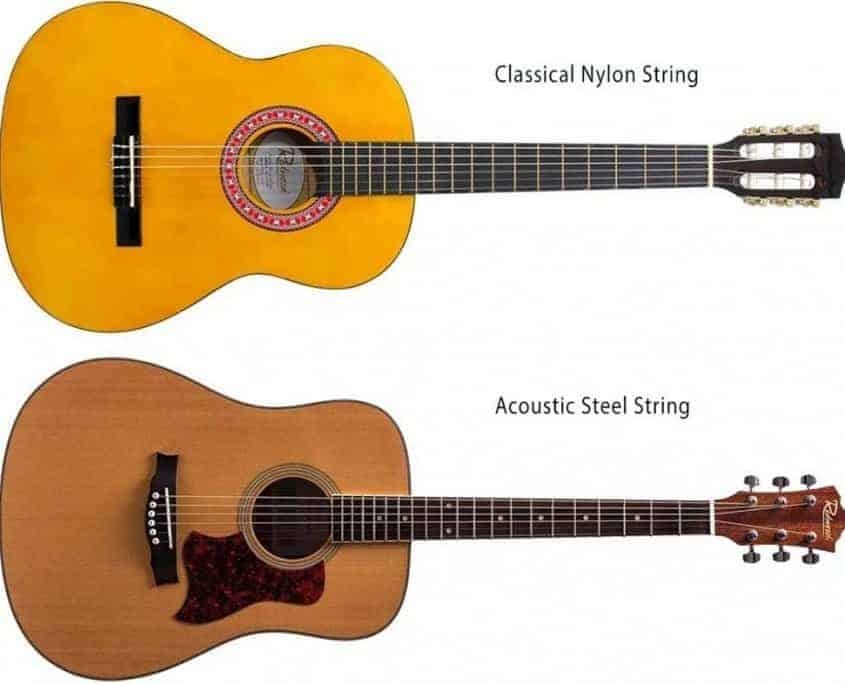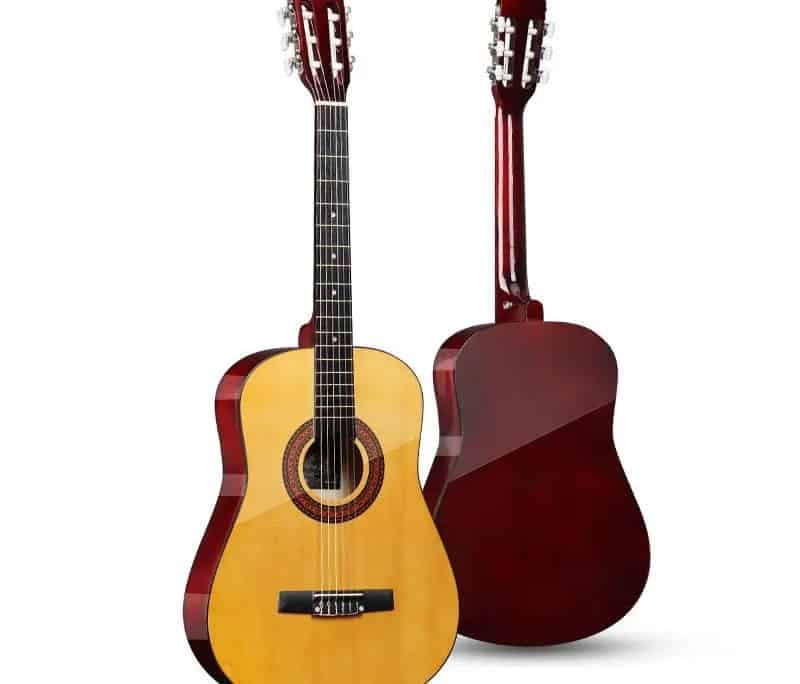Classical Guitar Strings
Introduction
Music has become a huge part of our lives – with classical music being in the heart of many. And no other instrument is better for classical music than the classical guitar.
Now, one of the most essential parts of a guitar is the string – you cannot really play one without using strings. That is why we have presented all the necessary information regarding classical guitar strings right here for you.
What is Classical Guitar Strings Made of?
Shockingly, as light-hearted as classical music sounds to be, the construction of classical guitar strings is quite far from that. Although that is not the case anymore, classical guitar strings were made using something different from what is used to make it now.
Here, we will discuss both the historical and the modern construction of these strings.

Figure 1: Materials of Guitar Strings
Before 1948
Until the second world war, a lot of things were gruesome – and the construction of classical guitar strings happens to be one of them. In those times, cow or sheep intestines were used to make the strings, which are often referred to as plain gut.
The three bass strings of the guitar were constructed using both silk core and gut for the extra bass effect. As horrifying or disgusting as it sounds, these materials actually worked pretty well when it came to delivering the perfect classical guitar string notes!
After 1948
Thanks to Albert Augustine, nylon guitar strings were soon discovered, and the use of plain gut for making them stopped shortly after. Since then, nylon has been widely used for making classical guitar strings – which include three bass strings and three treble strings.
The three treble strings were made of a single nylon filament; whereas, the bass strings were made by using a core of thin nylon threadlike filaments. These filaments were in turn wound with copper or silver-plated bronze wire for the full bass effect. However, steel is also used to make guitar strings – although that is mostly used in acoustic guitars.
If you hesitate to trust the quality of nylon strings, then we can assure you that Ariose Music will provide the best quality and the best service as a manufacturer for the suppliers.
The Number of Strings in a Classical Guitar
If you have ever come across a guitar, then you are obviously aware of the number of strings they tend to have. But there are no limitations on getting to know more and more about them – because it will help you be more cautious and knowledgeable as you purchase them.

Figure 2: Strings of Classical Guitar
Number of Strings
As we all know, a classical guitar comes with six strings. However, you can find them with seven strings as well from time to time.
That is because there is an extra note added to the guitar, which is referred to as the ‘G’ note. Hence, another string is added and these types of guitar are also known as Russian guitars – although they are classical as well.
Strings in Order
The strings of a guitar are named alphabetically. Therefore, you will find A, B, D, and so on strings in a guitar. Contrary to the natural order of things, the strings in a guitar are not organized alphabetically.
In fact, the first string in the classical guitar is the E string. Here, we will state the order of the strings, so you will have an idea regarding how it goes.
E
This is the first string in a classical guitar.
B
B is second both in the alphabet and among the guitar strings
G
G is the third-string in a classical guitar.
D
D is fourth both in the order of classical guitar strings and the alphabet.
A
The A string has taken the fifth spot in a classical guitar.
E
The first string and the sixth string of a classical guitar is the E string.
How to Tune
When tuning a classical guitar, it is essential to remember the order of the strings. For that, you can remember the order by memorizing some phrases or acronyms – or simply look it up.
How to Choose Classical Guitar Strings?
Confused about choosing the right classical guitar strings because you are not sure as to whether you will make the right choice or not? Well, we understand your dilemma – after all, what is a guitar without its strings, right? That is why we are here to help you make the best choice.
There are tons of aspects to think about when getting classical guitar strings. And we will list all the aspects that should be kept in mind when choosing them. If you adhere to all of these, then you will surely make the right choice.

Figure 3: Strings Classical Guitar
String Material
Even though classical guitars are usually made of nylon, there are other combinations that you should look out for. The materials determine the kind and tone of music the guitar will play with its strings. There are different material compositions for both treble and bass strings and we will discuss both for your convenience.
For Treble
The treble strings are often referred to as the E, B, and G strings. Mostly, clear nylon is used to construct treble strings – but it comes with plenty of other amazing options as well. Black nylon is another variant of nylon, which will produce a deeper and warmer tone.
You can also use titanium strings to get a crisper sound if your guitar is already too dark. Another bright sound-producing material is carbon fiber – it can amplify the tones of your guitar. Composite is another material that is mostly used for G strings for a smooth transition between treble and bass strings.
For Bass
Bass strings are the other three – A, D, and E. Now, these strings usually do not contain a pure nylon construction. They are made of various materials – a multifilament nylon core with a wrapping of other materials.
The most common wrapping materials are bronze with a mixture of zinc. But you can use silver as well to produce a warmer tone of the music. Furthermore, the core can be made of composite as well – so there can be various combinations of materials and you can conveniently pick the best combination according to the musical tone and such.
String Gauge
When we say string gauge, we are basically talking about its thickness. And yes, nylon strings can contain various thicknesses. The thickness of the nylon strings, however, varies non-linearly – that is, you won’t find any trend among the thicknesses of the strings.
The thickness increases from the E string to the G string and then goes down again at the D string. From there onwards, the thickness rises again. So, there is no linear trend – but you will have to remember the proportion of thicknesses before you purchase strings.
String Tension
Yes, the string tension is a thing among nylon strings, and it is indeed an essential factor because your playing tone will depend on it. There are three levels of tension – low, medium and high.
Low
The low tension strings produce the quietest volumes of music. They will generally be easier to play and they will also prolong the lifespan of the strings. Strings with low tension are mostly used for antique classical guitars.
Medium
If you are a beginner, then you would want to go for classical guitar strings with medium tension. This will provide the option of going higher or lower on the tone – as per your wish. And you won’t have much trouble playing them either.
High
High-tension nylon strings are mostly for professional guitarists. They produce the most volume and are usually the hardest to play. Furthermore, these are suitable for strumming.
If your brand is too confused about the quality of the classical guitar strings, then you can always rely on us, Ariose Music, to provide you with the best.
How To String A Classical Guitar?
One drawback of working with classical guitar strings is that you will have to change the strings quite often to keep the tone fresh and playable. And while that might seem hassle-some for starters, it is actually simple once you get the gist of it.

Classical Guitars
Figure 4: Classical Guitars
So here we will be explaining how you should string or change classical guitar strings.
Step 1: Unstring the previous strings
The first step is to obviously get rid of the former strings on the guitar. For that, you will have to slack the machine heads by turning them clockwise. Proceed to cut all the strings near the soundhole by using string snips or wire cutters.
Then you will have to take the string out from the barrel – and then from the bridge. Once you have removed all of the strings, it is time to clean the guitar.
Step 2: Clean the guitar
Dust the bridge off after removing the strings. Now, to clean the fretboard, you will need to hydrate it for 30 seconds using a cloth with some lemon oil.

Figure 5: Fretboard of Classical Guitars
After 30 seconds, wipe the fretboard using another cloth to dry it. Clean them thoroughly and don’t forget to polish them as well.
Step 3: Start stringing the thickest one
Once the cleaning part is done, you will have to prepare your new set of strings for installation. You will have to install the strings in order, and it is best to start with the thickest string.
Push 3 inches of the string into the bridge to bend it back and right over the bridge. In this way, you should create a loop using the string and pull the slack through. Do it once more and tie a knot using the 3 inches of string.
Step 4: Knot up all the strings
After you have tied the knot of the first string, you should repeat the process with the other strings. Take the tail of the first string and tuck it in under that of the second string. Keep on repeating the process until you are tying the knot of the last string.
Step 5: Cut the strings and tune
Once all the strings have been knotted up, you should start cutting the excess strings. Pull the thickest string of all through the nut. And then take a measuring scale to measure 15cm from the tuner roller.
Proceed to cut the excess string using a wire cutter. Pass the tail of the string over the roller and then make it go through the gap. After feeding it up through the hole and underneath, feed 7cm through the tuner roller.
Fold the tail of the string and make a loop. Use a string winder to keep the slack up while keeping the string up to tension. Once you are done, play the guitar and check if everything is set.
Here’s also a video on how you should restring a guitar for more clarity.
https://www.youtube.com/watch?v=JRR5cX8eS0g
Care and Maintenance of Classical Guitar Strings
Caring for and maintaining classical guitar strings is one of the most essential aspects of owning it. No matter how durable nylon and the other materials of the string seem to be, there’s no guarantee that they will last long without maintenance. Hence, here are some tips and tricks for keeping the strings intact.
Replace once every six months
As mentioned earlier, to keep the tone of a guitar fresh and new, it is necessary to change them every once in a while. And by every once in a while – we mean six months. You will get even better performance if you change them once every three months.
Wipe them down regularly
No matter how often you wash your hands before playing the guitar, your fingers can leave behind some sweat and moisture every time you play them. And since nylon strings are not played using picks – this part becomes essential. Wipe them down using wet tissues every time you play the guitar.
Loosen the strings when not playing
Too much tightness can cause some damage to the bridge of the guitar. Furthermore, they can cause swelling as well. Therefore, it would be wiser to loosen the strings up if you are not playing the guitar for a long time.
The lifespan of Classical Guitar Strings
Nylon may be a strong material – but nylon strings are quite delicate as a matter of fact. So, we will be discussing their actual lifespan here instead of providing a vague idea regarding it.

Figure 6: Lifespan of Classical Guitar Strings
Treble strings last longer than bass strings
Treble strings have a noticeably longer lifespan than bass strings. Some musicians tend to believe that treble strings can go on for years.
However, when replacing bass strings, it would be wise to replace the treble strings as well. Not to mention, you will have to care for both the bass and the treble strings too to keep them well.
The sound degrades within 80 hours of play
On average, the tone and sound of your nylon string will degrade within 80 hours of play. However, if you are a professional who uses different and harsh tones, then the lifespan of your strings may be shorter. As a result, you might have to replace them every 2-3 weeks.
Keep them cool and dry
As mentioned in the previous section, you should maintain your classical guitar strings. So, as long as you keep them cool and dry, they will not corrode.
How Much Should You Invest in Classical Guitar Strings?
Nylon strings will never cost you a fortune – they are very reasonable. Yet, it is best to have an idea about their cost, so you don’t end up paying more than what it is worth.
Between $5-$15
Most commonly used nylon strings will be available within this range. Strings that are made of pure nylon, without the addition of any other material, will cost around $5.
So, you can usually find treble strings around that price range. However, the pricing varies depending on the brand value as well – but anything over $20 is undoubtedly overpriced.
More than $15
Bass strings usually contain the addition of other materials as well. So, they can be a little more expensive than their treble counterparts. However, you can find them within $10-$20 and not more than that.
If you are confused about pricing and all, then you can easily rely on Ariose Music for suppliers.
How Do OEM Brands Help Suppliers Make Top Quality Classical Guitar Strings?
Before relying on any OEM brand for classical guitar string supplies, you should know a little more about them. And we are here to provide all the necessary information.
How Do OEM Brands Work?
OEM stands for Original Equipment Manufacturer. This brand basically produces a product and then sells it to another company.

Figure 7: Classical Guitar Strings Manufacturer
That company then resells the product under its own brand name. So basically, Ariose Music produces nylon strings that brands buy and sell under their own name.
Expertise and Experience of OEM Brands
The benefit of OEM brands is that they have the expertise and experience of making guitar strings according to the requirements of the buyers. Whether you want a specific tension, gauge or material to be included in the strings, OEM brands will integrate everything perfectly. As a result, your purchase from OEM brands will be rather cost-effective and satisfactory.
For instance, Ariose Music understands the requirements of its customers (suppliers and wholesalers) and then provides nylon strings accordingly. Whether there is a preferred string tension or gauge, we make sure to prioritize that when manufacturing custom strings for our wholesalers.
Best choice products, Fight ukuleles, Kringer music, BCP ukuleles, Tiger ukuleles, Gorge Community Music, Kirsten, Guitar list dot com are some of the top brands currently we are working with.
Frequently Asked Questions
1. Can I Put Normal Strings In Classical Guitars?
If the normal strings are made using nylon, you can put them in classical guitars. However, if you are planning on using steel strings, then we would strongly advise you against doing that. That is because steel strings are not made for classical guitars and they produce different tones entirely.
2. Can Acoustic And Classical Guitar Strings Be Used Interchangeably?
As we have mentioned previously, you cannot put steel strings in classical guitars, because they tend to produce different tones. So no, you cannot use acoustic and classical guitar strings interchangeably.
3. Are Steel Strings Better Than Nylon Strings?
That depends on your preference entirely. Steel strings tend to produce brighter music, which is why they usually have greater tension in their strings. However, nylon strings have lower tension and they tend to produce sounds that are more mellow. So if you are into brighter music genres, then you should definitely go for steel strings and vice versa.
4. What Kind Of Music Do Classical Guitars Play?
Classical guitars usually play classical music. However, classical music can incorporate many different sectors of music. For instance, classical music can contain notes of jazz, romanticism, etc. On the other hand, this type of music is usually written in sheet music notation.
5. Is it Essential to Use a Pick With My Classical Guitar Strings?
When it comes to classical guitar strings, it is better to use your fingers. In that way, you will be able to play classical music better. So, it wouldn’t be advised to use a pick with classical guitar strings. But you can use them for some notes and chords.
6. When Should I Change My Classical Guitar Strings?
Nylon strings have a lifespan of 3-6 months. They can last shorter or longer depending on care and maintenance. Moreover, you can tell by the degradation of their sounds whether they need to be replaced or not.
7. Do Classical Guitar Strings Provide A Better Sound?
Classical guitar strings tend to produce a quieter and mellower sound. For classical music, these are definitely better. For other genres, not so much.
Final Words
Classical music will never die no matter how modern the world turns out to be. And classical guitar strings are important to keep this genre of music alive. – that is why the classical guitar is one of our top-selling products. Hence, you should make the decision of getting them wisely.
Now that you know all about them, you will surely face no problem when purchasing them for your brand. But even if you do, you can easily send us a message for more details or for a sample/quotation.
Contents
- Classical Guitar Strings
- Introduction
- What is Classical Guitar Strings Made of?
- The Number of Strings in a Classical Guitar
- How to Choose Classical Guitar Strings?
- How To String A Classical Guitar?
- Care and Maintenance of Classical Guitar Strings
- The lifespan of Classical Guitar Strings
- How Much Should You Invest in Classical Guitar Strings?
- How Do OEM Brands Help Suppliers Make Top Quality Classical Guitar Strings?
- Frequently Asked Questions
- 1. Can I Put Normal Strings In Classical Guitars?
- 2. Can Acoustic And Classical Guitar Strings Be Used Interchangeably?
- 3. Are Steel Strings Better Than Nylon Strings?
- 4. What Kind Of Music Do Classical Guitars Play?
- 5. Is it Essential to Use a Pick With My Classical Guitar Strings?
- 6. When Should I Change My Classical Guitar Strings?
- 7. Do Classical Guitar Strings Provide A Better Sound?


